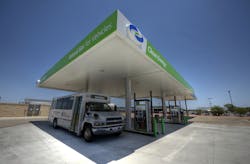Austin Takes Sustainability to the Next Level
Austin-Bergstrom International Airport (AUS) recently reached Level 3+ accreditation under the Airports Council International-North America’s Carbon Accreditation Program. It joins San Diego International Airport (SAN) and Vancouver International Airport (YVR) as the only airports in North America with the accreditation.
“We talked about it and it seemed like the right time,” said B.J. Carpenter Sustainability Coordinator, city of Austin Aviation Department. “This is a worldwide program that a lot of airports are utilizing to be a driver for their sustainability progress and to have one place to document it, so it seemed like a natural fit.”
The program tasks airport leaders with mapping the carbon emissions across their facilities and having it verified by an independent third party. They can find solutions to reduce CO2 emissions and implementing changes.
AUS isn’t new to sustainability initiatives. Leaders developed a strong environmental sustainability program years ago and executed initiatives, such as solar power installation, alternative fuel fleets and energy efficiency programs.
Participants start the program with mapping the carbon footprint of the airport. A third-party consultant then verifies the calculations, which gives the airport clear data on energy usage across all operational aspects.
The airport must demonstrate a reduction in carbon footprint. Airport leaders then bring together internal stakeholders to develop an engagement plan.
The program provides a framework, guidance and tools airport leaders need to plan and execute goals set via the program.
“Airports are a really tight knit group, so getting support to finding strategies to move forward through this program are readily available,” Carpenter said. “As we moved up the program, we even partnered with other airports in Texas to do some information sharing.”
Level 2 of the program aims are reduction of carbon footprint across the airport, starting with Scope 1 emissions, which covers energy and fuel usage onsite as an entity. Scope 2 examines electric usage in the airport and Scope 3 looks at energy usage for all tenants an airport can influence.
AUS made efforts to reduce Scope 1 emissions before joining the program, Carpenter said. The city mandated all facilities switch to green energy in 2012 harvested from west Texas wind farms. This effort alone dropped the airport’s carbon footprint by 75%.
All city facilities in Austin must meet LEED Silver standards, which Carpenter said the airport exceeds.
Airport vehicles and shuttle bus fleets also use biodiesel, E85, propane and compressed natural gas (CNG). AUS is now changing CNG shuttlebuses to Renewable Natural Gas (RNG). The move gave the airport extra carbon credits, which is shared with onsite parking companies to help them reduce their carbon footprint.
“We realized all the low hanging fruit had been picked, so the airport needed to reach higher to get the fruit and make improvements,” Carpenter said.
AUS continues to expand its electric ground support charging infrastructure to assist airline partners in switching out diesel equipment. Carpenter said they work with the airlines to get Diesel Emission Reduction (DERA) Grants and every new gate will have electrification infrastructure in place.
The airport is also working with Austin Energy to install Level 1 charging across a six-level parking garage to support growing electric vehicles in the market.
“We’re learning as we go,” Carpenter said. “Depending on the user and the expected, user we’re finding more affordable ways to put the technology in.”
Internal and external communications play a major role in aggressively tackling sustainability efforts. AUS works with its public information office to share different information about airport upgrades and technology so travelers understand the improvement and changes. It also sets internal goals to train employees on sustainability efforts with financial incentives set for meeting these measures.
But strong relationships and partnership within the community creates powerful tools to address sustainability efforts. Carpenter said a representative from their natural gas supplier reached out to him recently when he noticed a spike in energy usage, which showed heat was left on from a recent cold snap.
“It’s not just internal,” he said. “It involves all stakeholders.”
